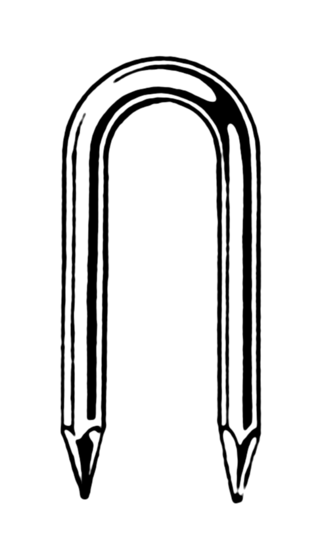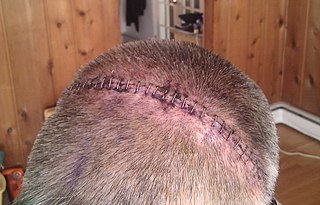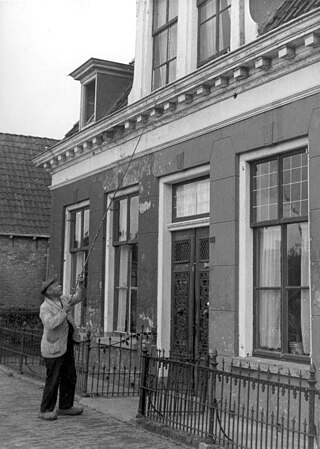
A wiki is a form of hypertext publication on the internet which is collaboratively edited and managed by its audience directly through a web browser. A typical wiki contains multiple pages that can either be edited by the public or limited to use within an organization for maintaining its internal knowledge base.

A staple is a type of two-pronged fastener, usually metal, used for joining, gathering, or binding materials together. Large staples might be used with a hammer or staple gun for masonry, roofing, corrugated boxes and other heavy-duty uses. Smaller staples are used with a stapler to attach pieces of paper together; such staples are a more permanent and durable fastener for paper documents than the paper clip.
A brush is a common tool with bristles, wire or other filaments. It generally consists of a handle or block to which filaments are affixed in either a parallel or perpendicular orientation, depending on the way the brush is to be gripped during use. The material of both the block and bristles or filaments is chosen to withstand hazards of its intended use, such as corrosive chemicals, heat or abrasion. It is used for cleaning, grooming hair, make up, painting, surface finishing and for many other purposes. It is one of the most basic and versatile tools in use today, and the average household may contain several dozen varieties.

Upholstery is the work of providing furniture, especially seats, with padding, springs, webbing, and fabric or leather covers. The word also refers to the materials used to upholster something.

A staple gun or powered stapler is a hand-held machine used to drive heavy metal staples into wood, plastic, or masonry. Staple guns are used for many different applications and to affix a variety of materials, including insulation, house wrap, roofing, wiring, carpeting, upholstery, and hobby and craft materials. These devices are also known as trigger tackers.

The swish cymbal and the pang cymbal are exotic ride cymbals originally developed and named as part of the collaboration between Gene Krupa and the Avedis Zildjian Company. The current Zildjian Swish Knocker is a redesign of their original swish, with more rivets, deeper bow and shallower bell, based on a cymbal made famous by Mel Lewis, who coined the name knocker.
The Online Certificate Status Protocol (OCSP) is an Internet protocol used for obtaining the revocation status of an X.509 digital certificate. It is described in RFC 6960 and is on the Internet standards track. It was created as an alternative to certificate revocation lists (CRL), specifically addressing certain problems associated with using CRLs in a public key infrastructure (PKI). Messages communicated via OCSP are encoded in ASN.1 and are usually communicated over HTTP. The "request/response" nature of these messages leads to OCSP servers being termed OCSP responders.

Golf is a card game where players try to earn the lowest number of points over the course of nine deals.

A door knocker is an item of door furniture that allows people outside a house or other dwelling or building to alert those inside to their presence. A door knocker has a part fixed to the door, and a part which is attached to the door by a hinge, and may be lifted and used to strike a plate fitted to the door, or the door itself, making a noise. The struck plate, if present, would be supplied and fitted with the knocker. Door knockers are often ornate, but may be no more than a simple fitting with a metal bob, or ring.

A staple remover is a device that allows for the quick removal of a staple from a material without causing damage. The best-known form of staple remover, designed for light-gauge staples, consists of two opposing, pivot-mounted pairs of thin, steep wedges and a spring that returns the device to the open position after use. Although a simple metal wedge can be used for the same purpose, and although some staplers feature such a wedge at their hinge end, use of the wedge tends to tear fragile papers.

Surgical staples are specialized staples used in surgery in place of sutures to close skin wounds or connect or remove parts of the bowels or lungs. The use of staples over sutures reduces the local inflammatory response, width of the wound, and time it takes to close.
Knocker and knockers may refer to:

In body modification, an implant is a device that is placed under the human skin for decorative purposes. Such implants may be subdermal or transdermal. In the context of body modification, some may consider injections of silicone and other substances a type of implant as well.

A knocker-up or knocker-upper was a member of a profession in the Netherlands, Britain, Ireland, and some other countries that started during, and lasted well into, the Industrial Revolution, when alarm clocks were neither cheap nor reliable. A knocker-up's job was to rouse sleeping people so they could get to work on time. By the 1940s and 1950s, this profession had more or less entirely died out, although it still continued in some pockets of industrial England until the early 1970s.
The Online Certificate Status Protocol (OCSP) stapling, formally known as the TLS Certificate Status Request extension, is a standard for checking the revocation status of X.509 digital certificates. It allows the presenter of a certificate to bear the resource cost involved in providing Online Certificate Status Protocol (OCSP) responses by appending ("stapling") a time-stamped OCSP response signed by the CA to the initial TLS handshake, eliminating the need for clients to contact the CA, with the aim of improving both security and performance.
The Commer TS3 was a diesel engine fitted in Commer trucks built by the Rootes Group in the 1950s and 1960s. It was the first diesel engine used by the company.

The AEC Militant was a post-war development by AEC of the AEC Matador artillery tractor used during World War II. Externally the most noticeable development was the cab, which was considerably enlarged. Unlike the Matador only six-wheel versions were produced. Four-wheel versions are extant, but they are probably conversions and one is a Matador with a Mk1 Militant cab. Other changes included the fitting of a larger, 11.3-litre 6-cylinder, diesel engine and the use of a steel frame for the cab, rather than the ash wood frame of the Matador. The Militant Mark 1 was produced in 6×4 and 6×6 form.

Mairi Lambert Gooden Chisholm, of Chisholm, MM, OStJ, known as Mairi Chisholm, was a Scottish nurse and ambulance driver in the First World War. She, together with her friend Elsie Knocker, won numerous medals for bravery and for saving the lives of thousands of soldiers on the Western Front in Belgium. Dubbed "The Madonnas of Pervyse" by the press the two were among the most photographed women of the war.

Beninese cuisine involves many fresh meals served with a variety of sauces. Meat is usually quite expensive, and meals are generally light on meat and generous on vegetable fat.

Knocker White is a Dutch-built tugboat, currently preserved as a museum ship at Trinity Buoy Wharf. She was built in 1924 by T. van Duivendijk, Lekkerkerk, Netherlands for Harrisons Lighterage Company, under the name Cairnrock.















